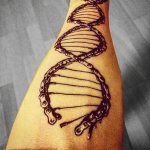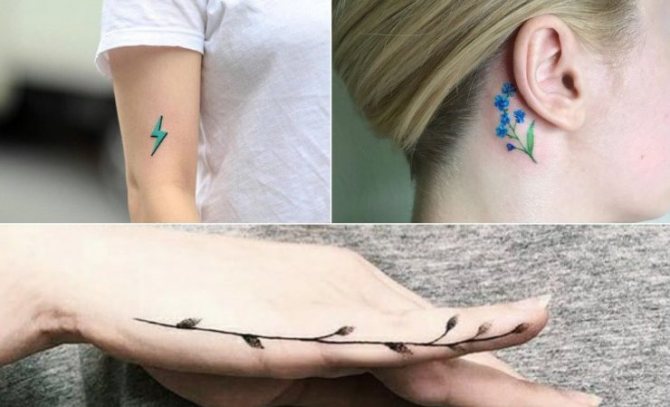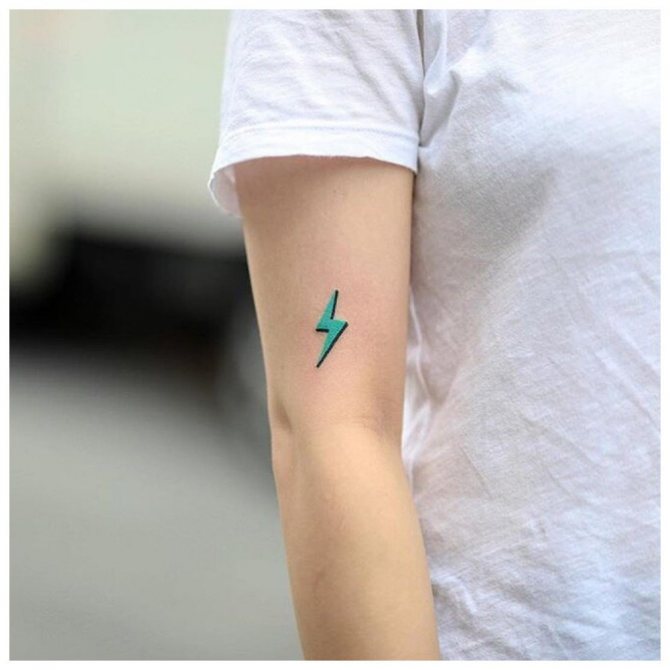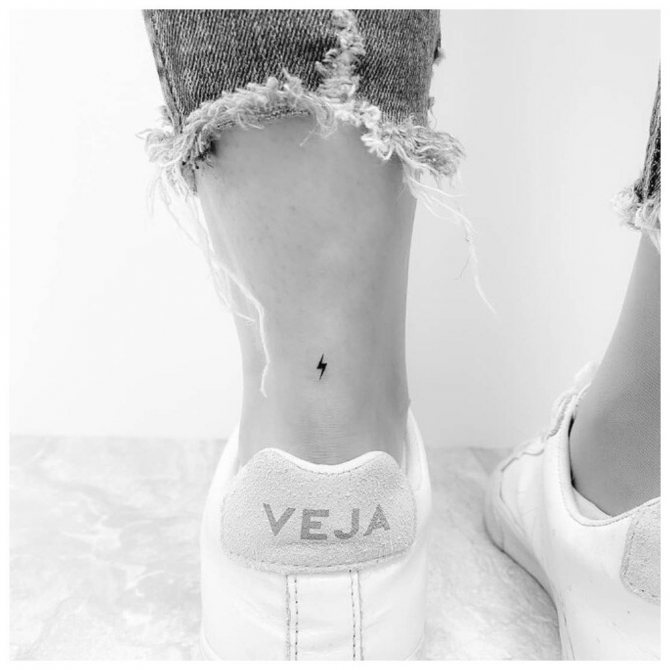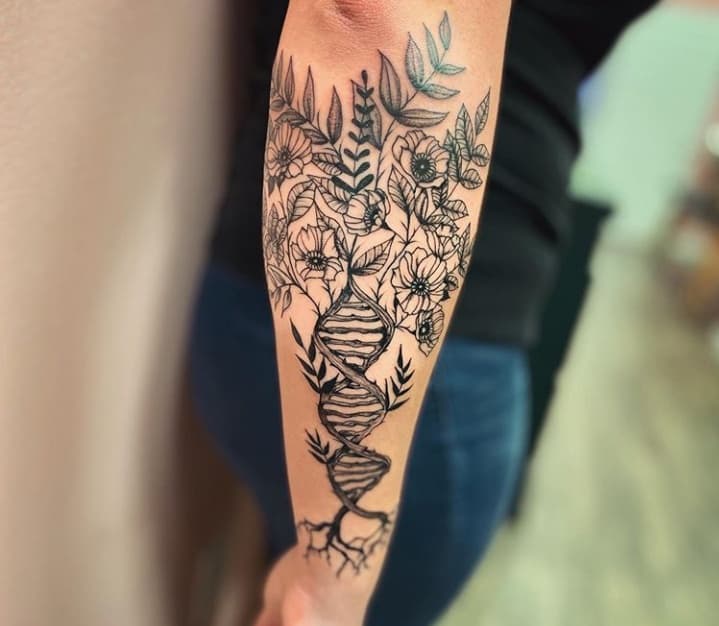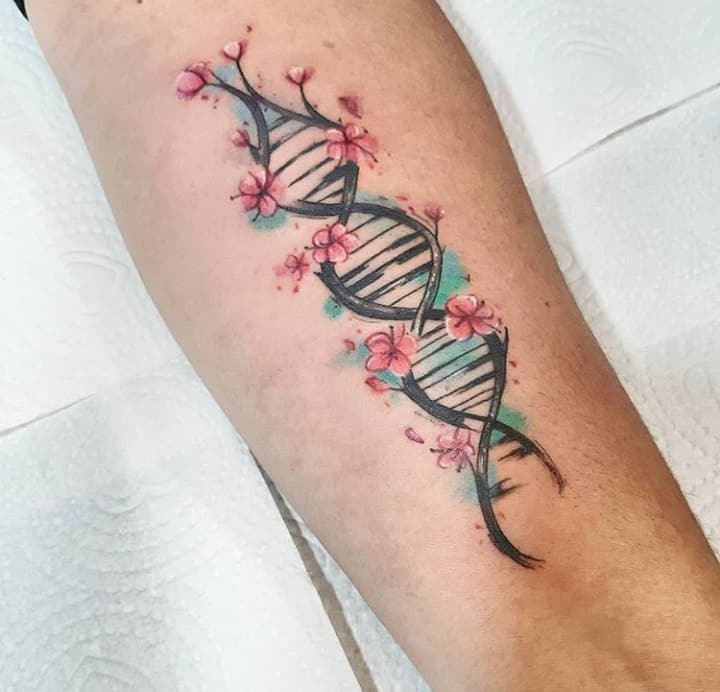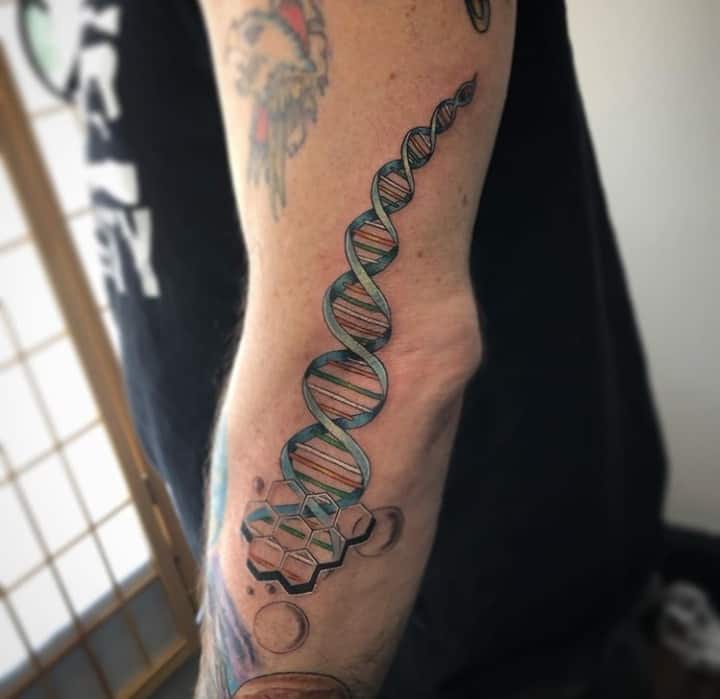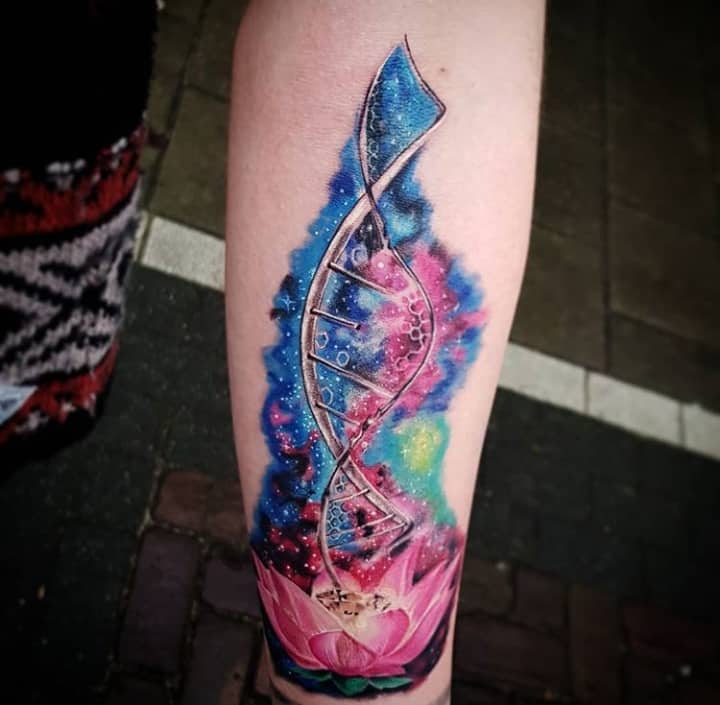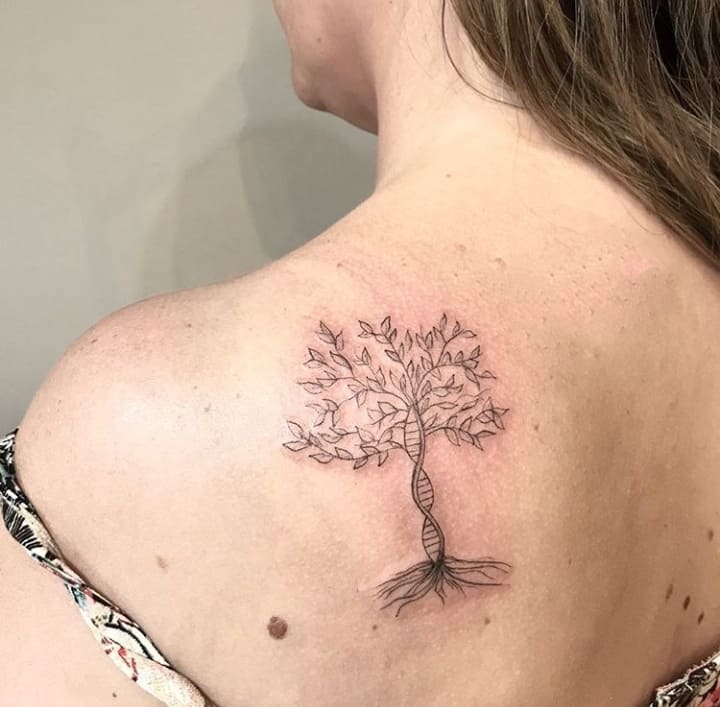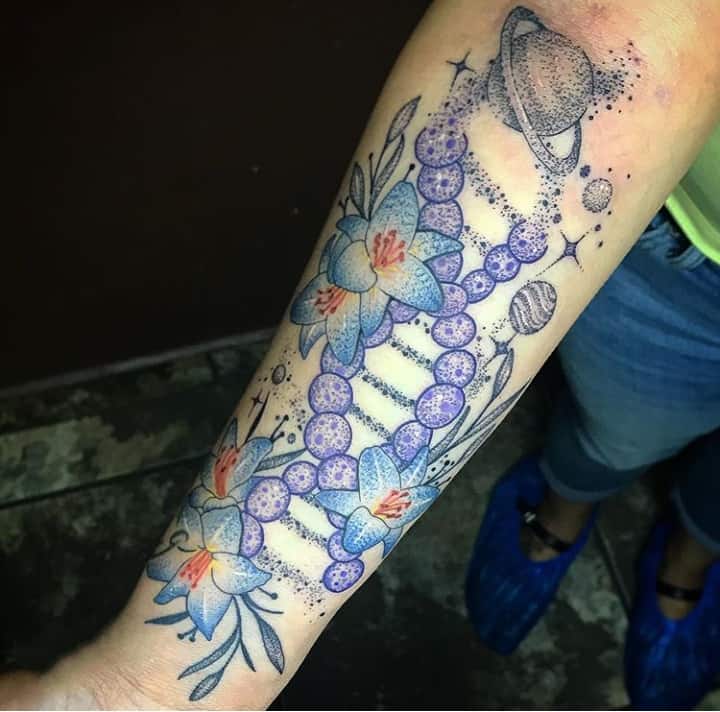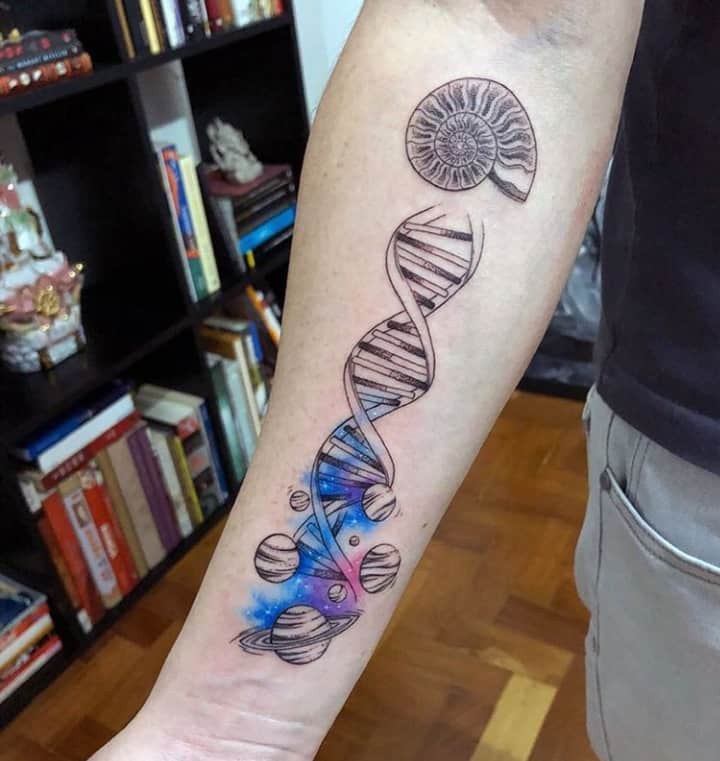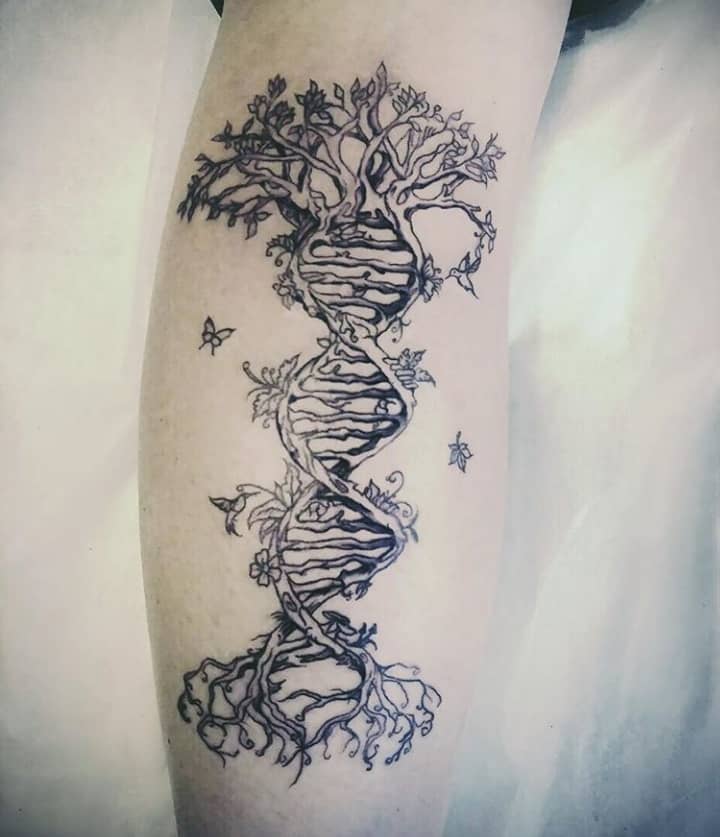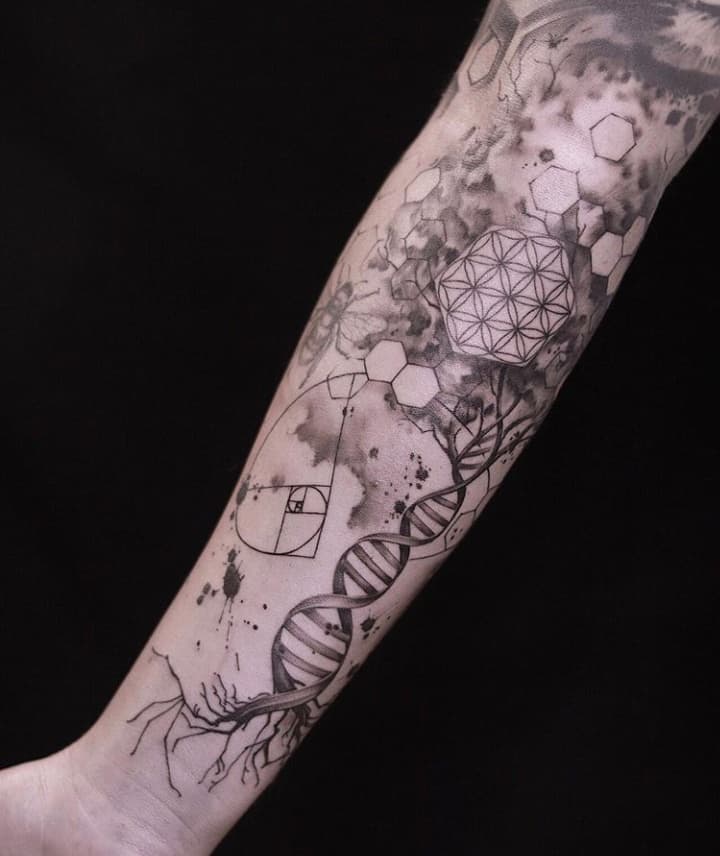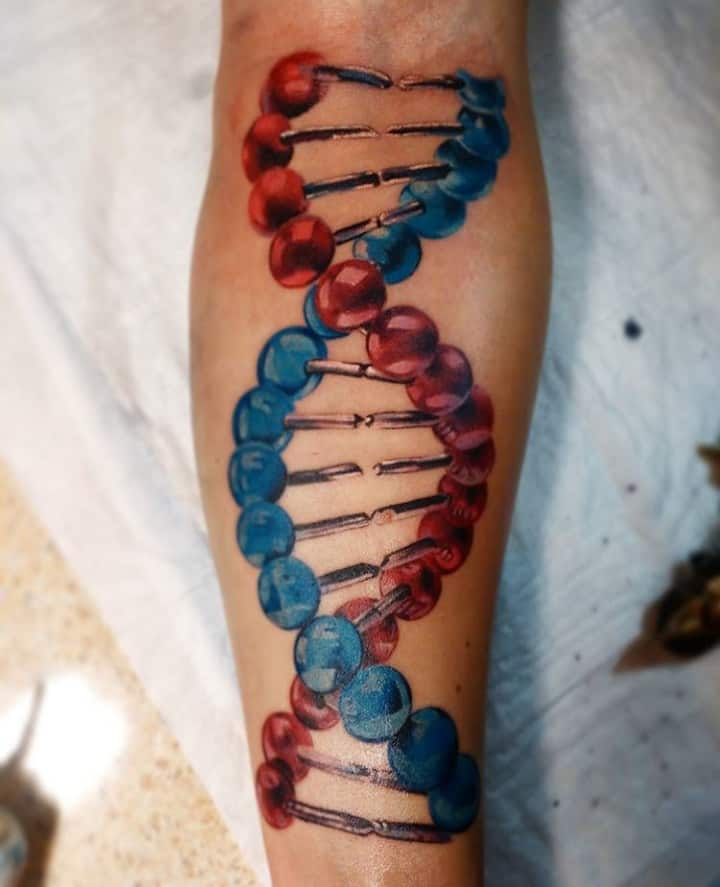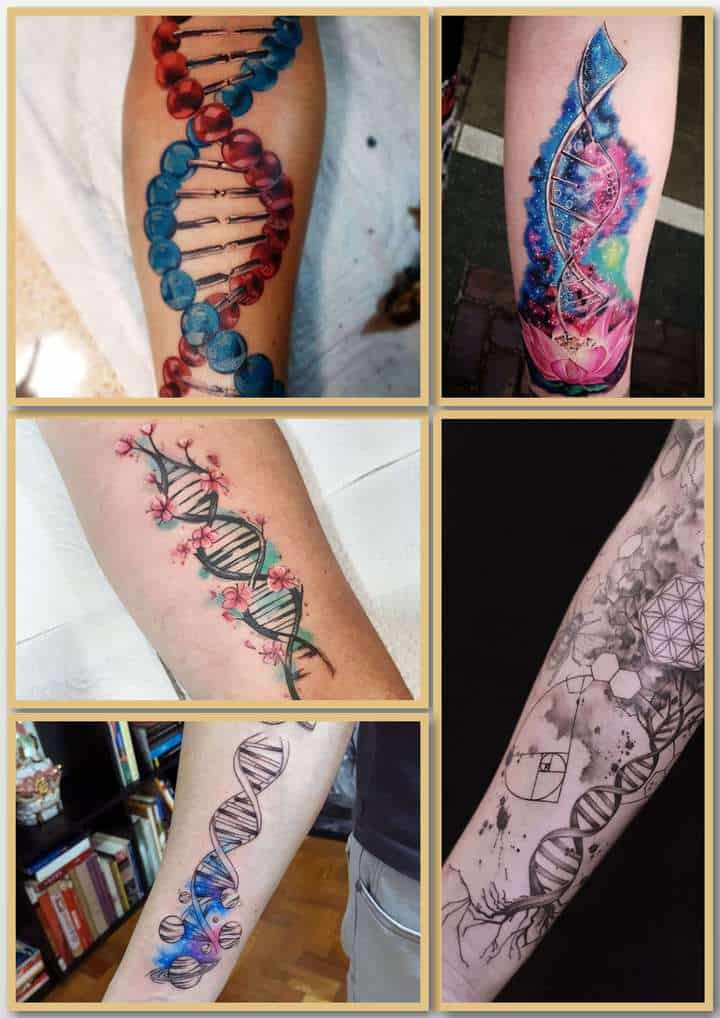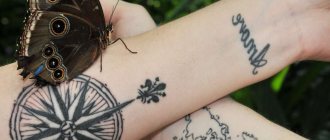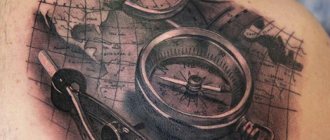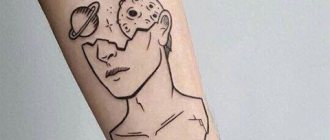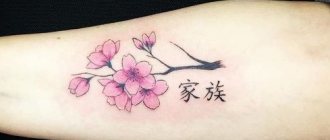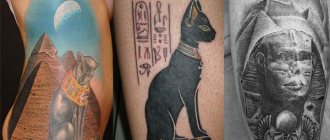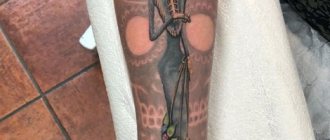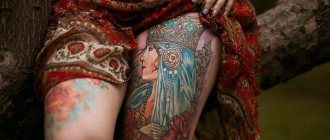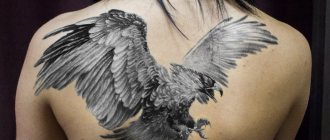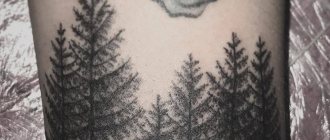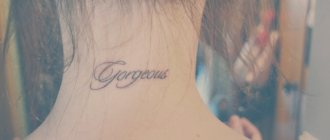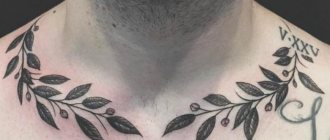Drawing on the body of the figure of scientific subjects, for example, DNA tattoo is an opportunity to demonstrate to the surrounding people the high intelligence, originality, uncommonness and philosophical orientation of thinking. To tell about your vision of the world, to emphasize the range of scientific interests and look modern and stylish at the same time. Mathematical formulas, physical models, macromolecules imprinted on a person get a new meaning due to the advantages they give to modern society.
And the tattoo of the DNA molecule makes us think about the origin and evolution of all living things and about the capabilities of man as a result of the discovery of this molecule.
The general meaning of the DNA macromolecule
In the middle of the last century, it was possible to image DNA. This was done with the help of X-ray crystallography. No one knew how the macromolecule worked at the time. Chemists and biologists conducted many experiments. As a result of lengthy research, DNA was deciphered. The DNA test revealed the code of heredity. The method made it possible to establish the degree of kinship, hereditary diseases, and so on. As a result, data about each individual's DNA could improve the quality of life of humanity as a whole.
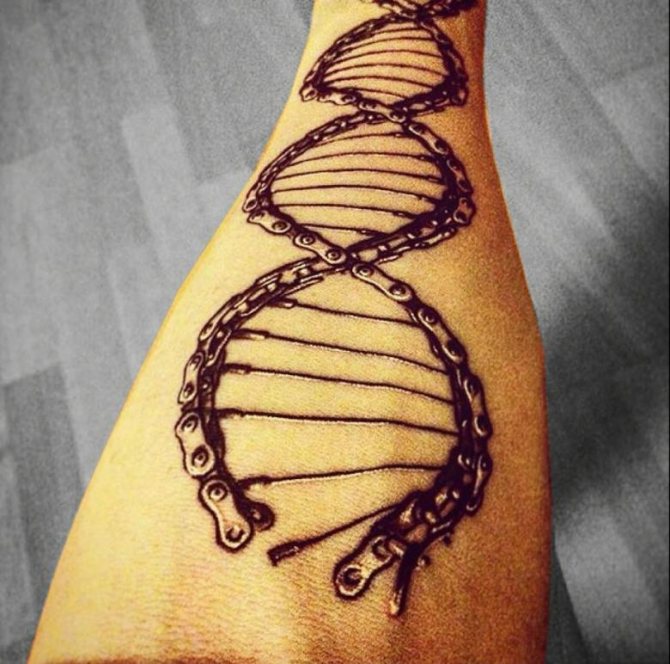
The image of the macromolecule became fashionable. Printed drawings are made into paintings; musicians create new tunes based on DNA sequences. They also create sculptures, such as one where a mouse knits a molecule out of a spiral. Specialized salons create DNA chain tattoo designs.
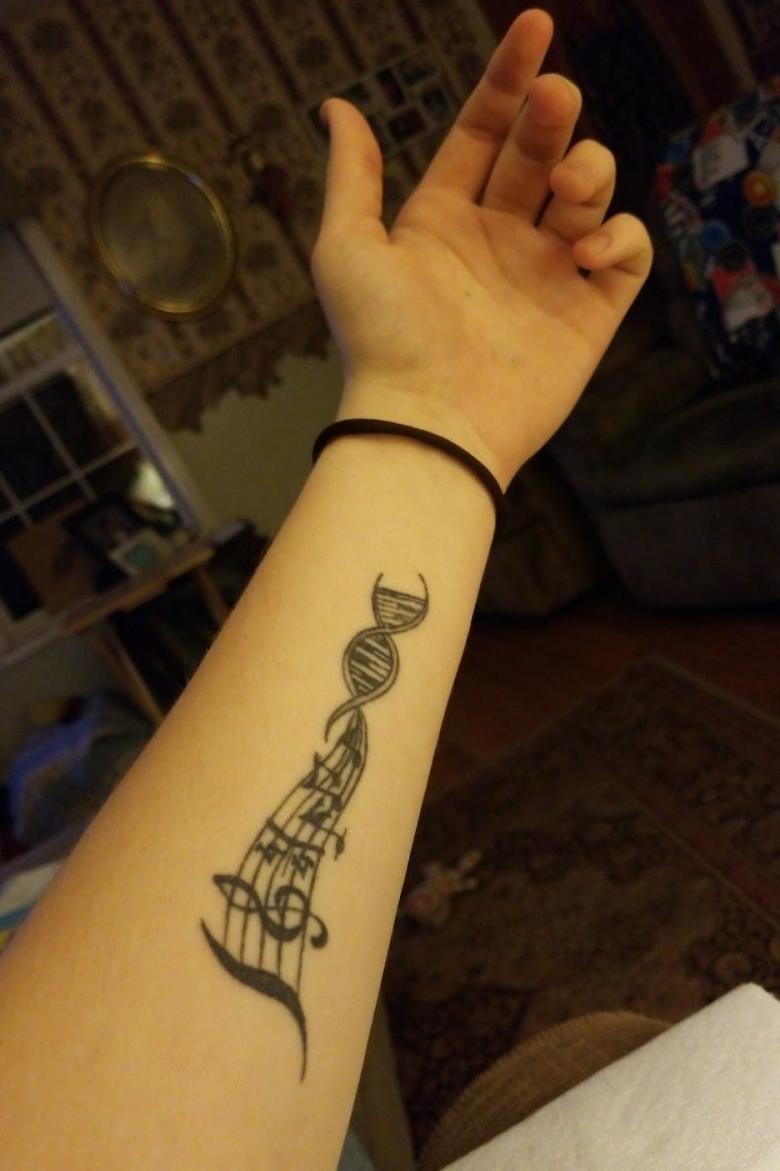
The meaning of tattoos for girls
A DNA tattoo is a symbol of an intelligent, well-read and scientific person. Often such a drawing on the body is not just a tribute to fashion, but a sign of professional interest in the study of the genome. The tattoo is chosen by girls, whose career is associated with scientific research or laboratory research of DNA.
The connection with previous generations and in general to all life on the planet symbolizes the tattoo, where the double helix of DNA is represented as a tree trunk. Tattoos with philosophical connotations are preferred by girls who have formed the worldview, keeping their principles, able to look at the world in a non-standard way. An unusually broad outlook makes them interesting and wise interlocutors.
Tattoo DNA for men
In men, the DNA tattoo also denotes his belonging to scientific circles. As a rule - it is a microbiologist and is immersed in genetic engineering. In this case, the profession and field of fascination lie on the same plane. It is common to say about such symbiosis that a person has found his vocation. It means he is satisfied and in demand. The tattoo of macromolecules will further strengthen the owner in the right choice of life's path.
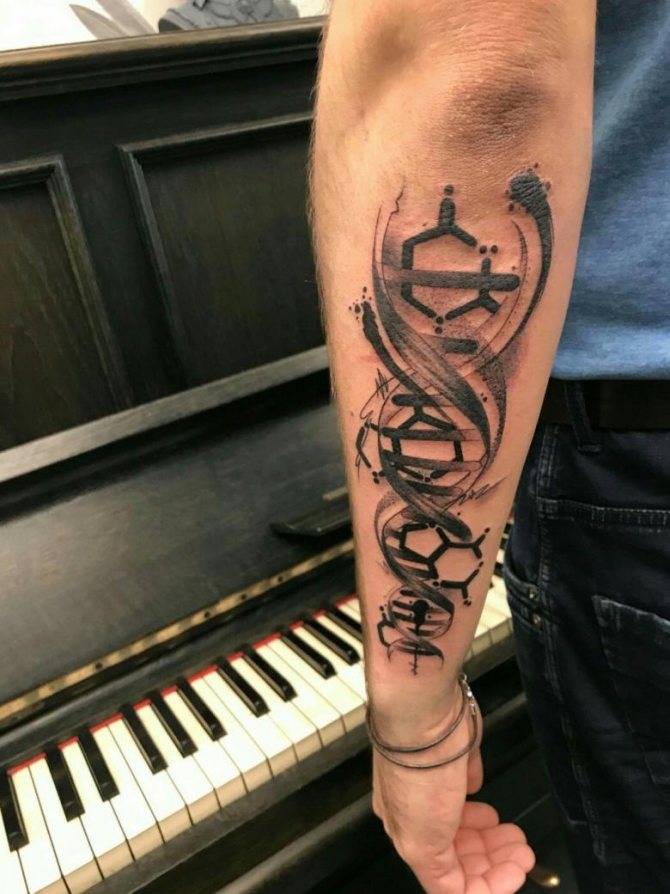

Men with a broad mind, inquisitive and open-minded, often make a tattoo in color, in the style of watercolor. Often the spiral is complemented by a peculiar detail. This can be a plant print, a space rocket, a globe and other objects.
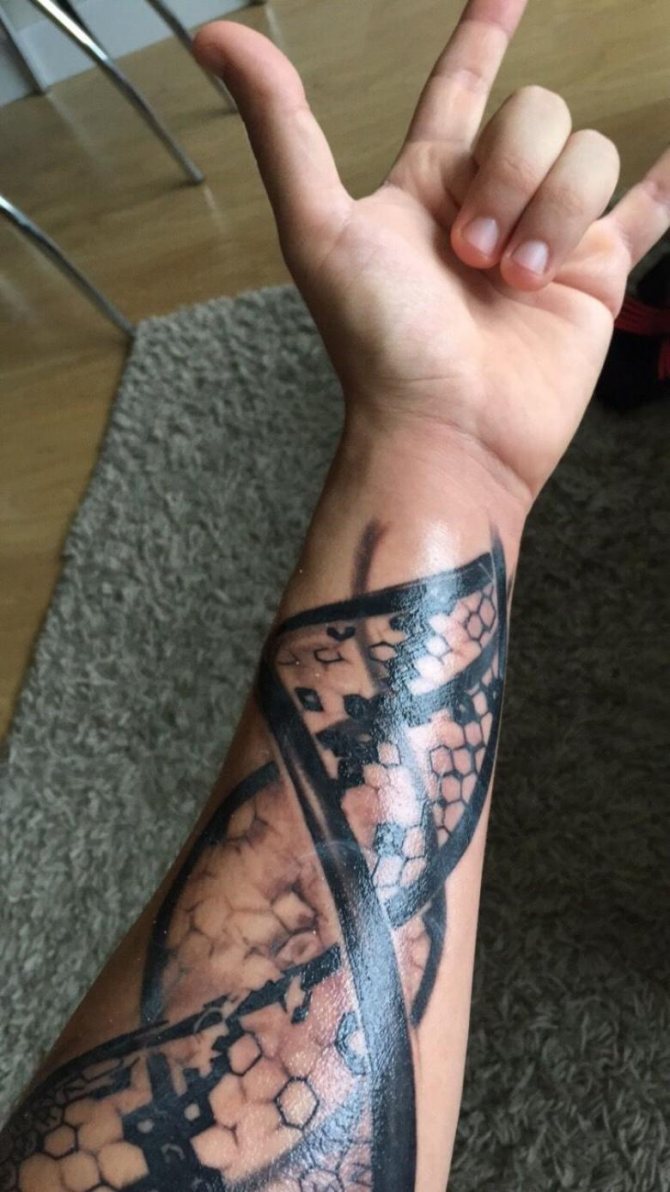

Turn in the wrong direction.
Already in itself, the double spiral can be arranged in different ways. Rosalind Franklin noticed this, even though she had no idea that she was facing a spiral, or even a double spiral. Under normal conditions, reminiscent of intracellular DNA in the biologist's photographs had a "loose" shape, which Franklin called B-DNA. But if the humidity in the test tube dropped below 75 percent, the result was A-DNA, broader and thicker.
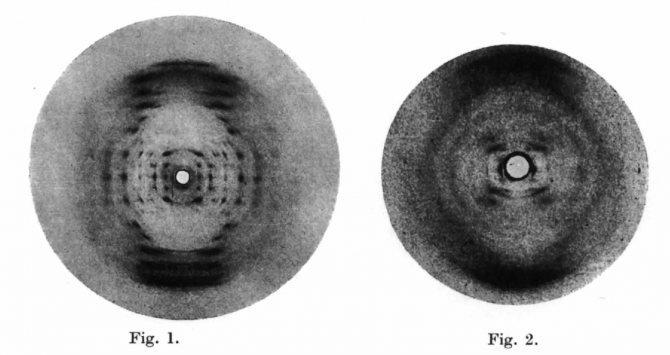

A (left) and B (right) forms of DNA as Rosalind Franklin saw them
Rosalind Franlkin, Raymond Gosling / Acta Crystallographica, 1953
Share
As it turned out later, A-DNA is indeed tighter: it takes 10 nucleotides per helix, not 11 as in B-DNA. And they are not perpendicular to the axis of symmetry of the helix, but at an angle: if in B-DNA nucleotides are usually depicted by horizontal dashes, in A-DNA they should be drawn obliquely.
Watson and Crick chose B-DNA as the basis for their model and did not go wrong. Later, it turned out that the B-variant does occur much more frequently in the cell, and it is now considered the main form of DNA existence, and all deviations are often referred to by the general term "non-B DNA".
Moreover, the real double helix almost never conforms to its idyllic model. In living systems, B-DNA is usually twisted a bit tighter than Watson and Crick predicted, and the average number of nucleotides per helix turn in it is not 10 or 11, but about 10.5. Besides, separate pairs of nucleotides constantly deviate from the laid down "horizontal" (it is called "propeller turn"), so the helix is never absolutely smooth and flat - here and there roughnesses stick out on its sides: the ends of nucleotides are at different angles.
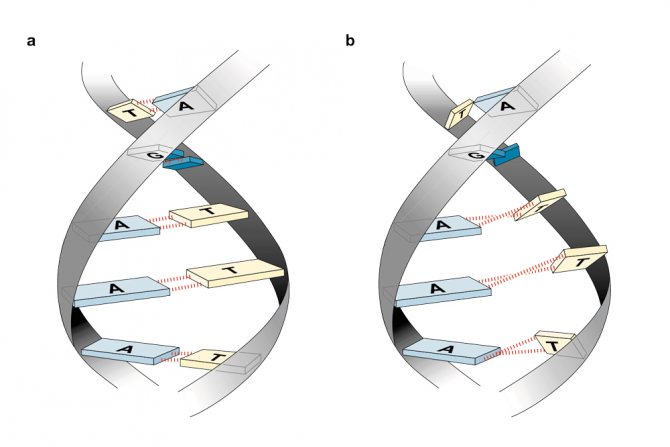

"Propeller" rotation of nucleotides in B-DNA
James D. Watson et al. / Molecular Biology of the Gene, 2008
Share
Later it turned out that the coils of the spiral can not only lie tighter or looser, but can also be twisted counterclockwise (for example, the spiral of the Evolution Tower in Moscow City is twisted to the left, clearly symbolizing the DNA strand). By a strange coincidence, this was the DNA seen in 1979, when it finally became possible to look at nucleic acids with high resolution. It was still a double helix, but of a very different shape: 12 nucleotides per helix, even thinner than B-DNA and twisted not to the right but to the left. The phosphate groups protruding from the surface formed a zigzag instead of a smooth helix, so the new variant was called the Z-form.
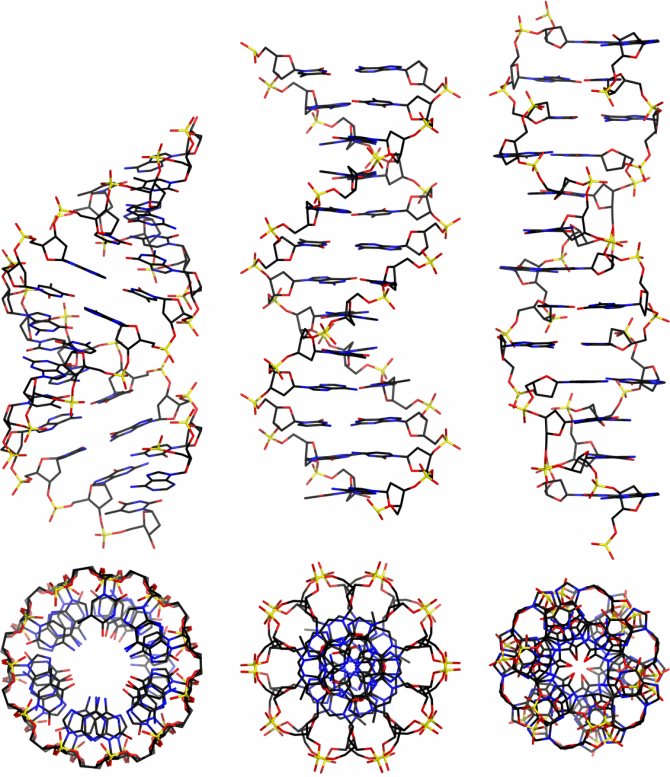

A-DNA (left), B-DNA (center), Z-DNA (right)
Mauroesguerroto / wikimedia commons / CC BY-SA 4.0
Share
This, of course, did not mean that the Watson-Crickson model was wrong. The Z-form was obtained under rather exotic conditions - in a solution with a high concentration of salts. And in the cell it is also obtained from B-DNA only under certain circumstances: for example, when the "voltage" on the chain is too high and it needs to be reset. Tension is caused by excessive twisting: the DNA strands are already twisted relative to each other, but the double helix they form is twisted onto some protein (e.g., histone), causing what is known as
superspiralization
. Switching to the Z-form helps to release the tension and unwind the extra turns - and this, in turn, is important so that new proteins can bind to the DNA, such as polymerase during transcription.
This is why DNA often assumes a Z-shape when genes are transcribed. Moreover, the more Z-DNA there is, the more active the transcription is. Histones cannot bind to Z-DNA, so no one stops the polymerase from doing its job. And this, by the way, is actively used by tumor cells, in which the left-handed helix occurs in time before the genes they need.


Evolution Tower (foreground) has the appearance of left-twisted DNA
mos.ru / CC BY-SA 4.0
Share
Then other forms of the double helix were found. Depending on humidity, salt content and the sequence of nucleotides in a given site, DNA may become even longer (E-DNA) or shrunk (C- and D-DNA), involve metal ions (M-DNA) or be stretched so that phosphate groups (S-DNA) appear in the center of the helix instead of nitrogenous bases. And after other types of intracellular DNA like nuclear N-DNA and recombinant R-DNA (which, by the way, got on the list not because of their shape but because of their position in the cell or origin) were added to the list, the English alphabet for DNA variants almost ran out of letters. Anyone who decides to discover another non-canonical form will have to choose from five free ones: F, Q, U, V, and Y.
Alphabetical list of DNA forms
A-DNA
- Double-stranded, slightly thicker than B.
B-DNA
- The one built by Watson and Crick.
C-DNA
- double-stranded, 9.3 nucleotides per strand.
D-DNA
- double-stranded, narrow: 8 nucleotides per strand, contains many thymines.
E-DNA
- double-stranded, even narrower: 15 nucleotides per two turns.
G-DNA
- A quadruple helix with guanine tetrads.
H-DNA
- triple helix.
I-DNA
- Two double helixes held together by the attraction of their cytosines.
J-DNA
- Another triple helix formed by AC repeats.
K-DNA
- Trypanosome DNA, especially rich in adenines.
L-DNA
- DNA that is based on L-deoxyribose (not D- as usual).
M-DNA
- B-DNA complexed with divalent metals.
N-DNA
- nuclear DNA.
O-DNA
- DNA doubling initiation point in bacteriophage λ.
P-DNA
- Pauling and Cory triple helix.
R-DNA
- recombinant DNA (obtained by incorporation of a foreign fragment).
S-DNA
- double-stranded, elongated 1.6 times more than B-form
T-DNA
- resembles the D-form, found in bacteriophage T2.
W-DNA
- synonymous with Z-DNA.
X-DNA
- A double-stranded helix formed by AT repeats.
Z-DNA
- double-stranded left-handed stranded.
The macromolecule chain
Among scientists, there are those who like simple drawings, like from a science book. Without any embellishments. Such a real tattoo of a DNA molecule refers immediately to the scientific background of the symbol. Though attractive in appearance, the tattoo awakens thoughts about the origin/development of mankind, makes us look for ways to study civilizations that existed before.
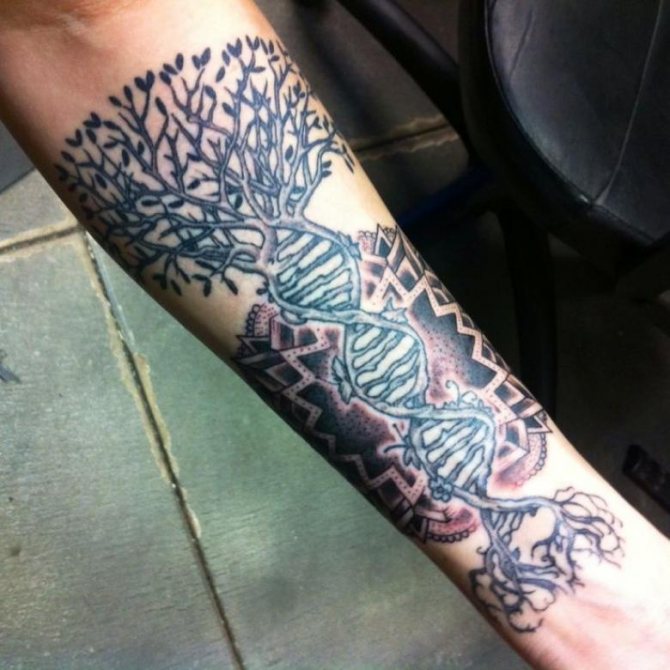

Actors with a sense of humor can express in a tattoo the peculiarities of their character, appearance. For example, they can get a DNA tattoo consisting of multicolored links. Sometimes they are even connected randomly. But this does not indicate the stupidity of the person or his failure as a scientist. It's just a character trait that helps him or her unfold in his or her chosen field of science.
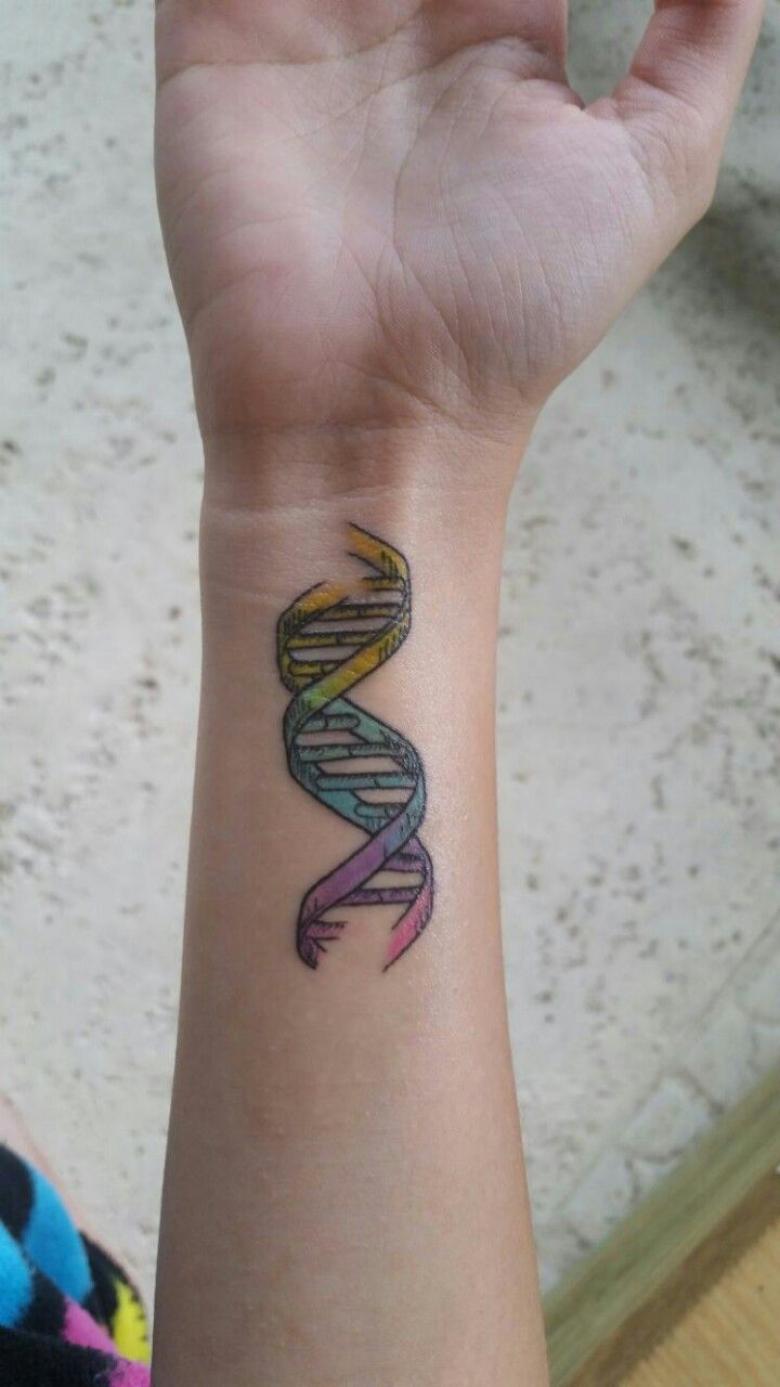

Sketch ideas.
Watson and Crick weren't the only ones poring over a three-dimensional model of DNA. They weren't even the first. A wide variety of molecular forms could be constructed from scraps of biochemical data, and there were many variations.
The conditions of the problem were all the same. By early 1953, it was already clear how the nucleotide was constructed:
- phosphoric acid residue,
- sugar,
- one of the nitrogenous bases: adenine (A), guanine (G), thymine (T), or cytosine (C).
It was still known that the nitrogenous bases were not randomly scattered along the chain: in any DNA molecule, the total number of adenines and guanines was strictly equal to the number of thymines and cytosines. In addition, in all of Rosalind Franklin's and Raymond Gosling's X-rays, regardless of which section of DNA was imprinted on them, the strand itself had the same thickness. This meant that the shape remained unchanged at any nucleotide sequence.
From these inputs Linus Pauling and Robert Corey assembled their model - a triple helix bristling with nitrogenous bases on all sides (the biochemists gave phosphate and sugar the role of the inner core). This construction looked unstable: it was unclear why the negatively charged phosphate groups in the center of the helix did not repel each other.
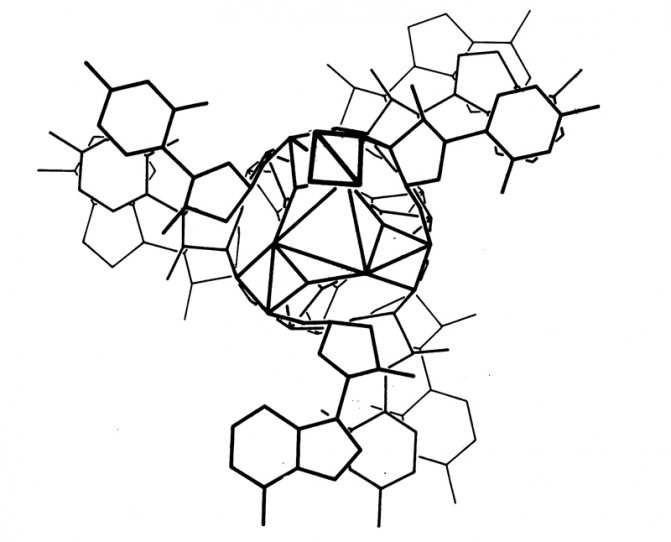

Structure of DNA according to Pauling and Cory
Linus Pauling, Robert B. Corey / PNAS, 1953
Share
Bruce Fraser solved this problem by turning the structure inside out: in his version, the three strands looked phosphate outward. The nitrogenous bases were facing inward, but Fraser was never able to explain the principle by which they were connected.
Watson and Crick's model with the double helix twisted to the right proved to be the most stable. Like Fraser, the scientists placed the phosphates on the outside and the nitrogenous bases on the inside. There was also a clear principle of their opposition in this model: A on one chain was always connected with T on the other, and D with C. This explained why the thickness of the structure was stable - A-T and G-C pairs were about the same size.
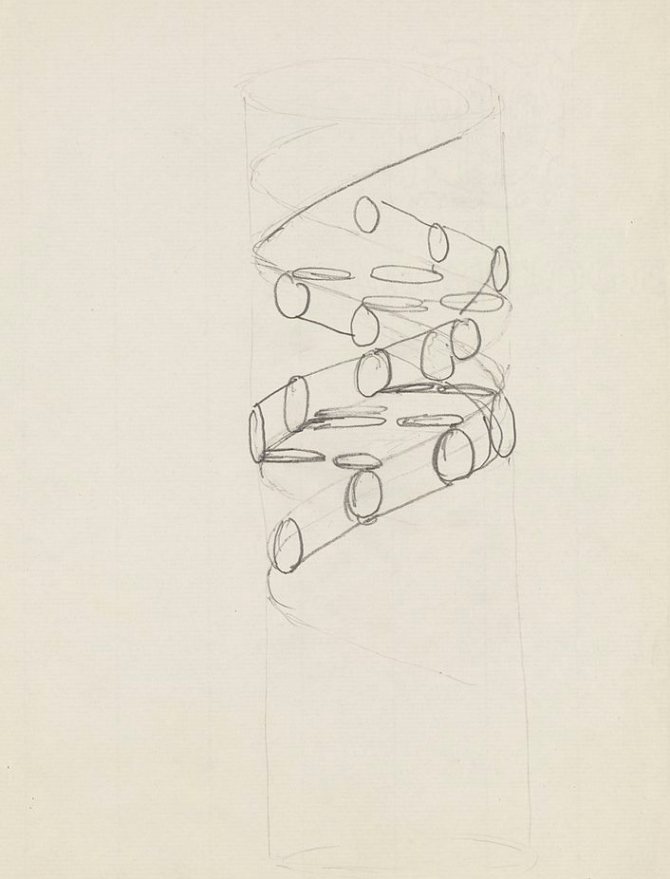

Pencil sketch of DNA structure by Francis Crick
Wellcome Images / CC BY-SA 4.0
Share
Then there were other attempts to reassemble DNA into a new form. Dutch biochemist Carst Hoogsteen, for example, noticed that it was possible to connect the same pairs of nucleotides with other faces - so the helix also remained stable, but was thinner. Other authors depicted DNA as a spiral with alternating right and left turns, or even as two double spirals that form a single quadruple. Although the existence of the Watson-Crickson double helix has been confirmed many times since then, in the 21st century we continue to speculate on what forms the DNA strand takes inside the cell, where it is much more difficult to see than in the test tube. True, none of the alternative ideas so far have been good enough to do away with the classic right-handed double helix.
Watson and Crick did more than just settle the debate over the shape of DNA. Their model immediately explained how this shape works: a mutually unambiguous correspondence makes each strand a template for the other. Having only one of the strands, it is always possible to reconstruct the second one from it - a principle on which all modern models of genetic information transmission rely.
Nevertheless, most of the "rejected" ideas turned out to be correct in some way. In almost 70 years of close scrutiny of DNA, it has been able to detect almost every possible type of base connection, other helices, and even a left turn.
The DNA molecule
A tattoo of DNA does not imply a great deal of detail. No matter how it is drawn, it remains laconic. At the same time, it is not devoid of sophistication. Usually on such a tattoo are solved by people who are in the subject. For example, scientists in the field of genetic engineering, biology and chemistry. And they prefer a monochrome image. They understand that this is not just a decoration, but a way to indicate their belonging to a certain circle of people.
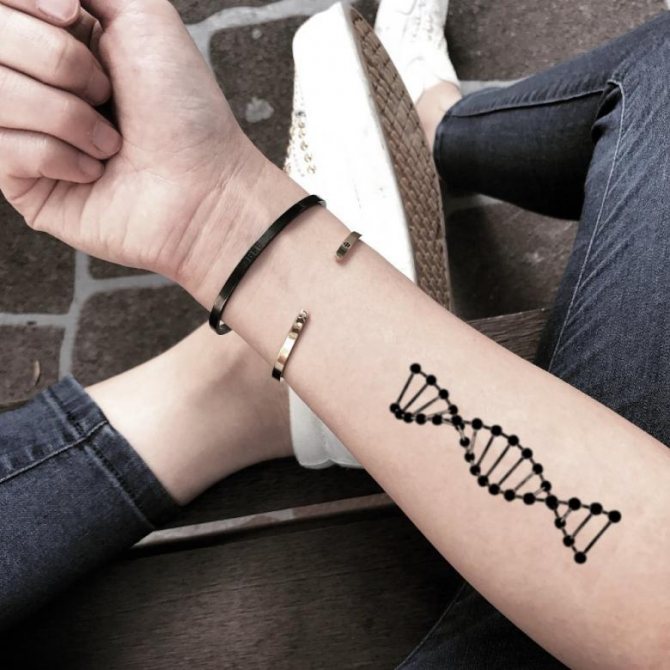

More romantic individuals from this environment are not alienated by color images. This indicates the presence of diverse interests, the sociability. That is, they are not alien to everything human, but they sincerely believe in new discoveries, ready to serve science with full dedication.
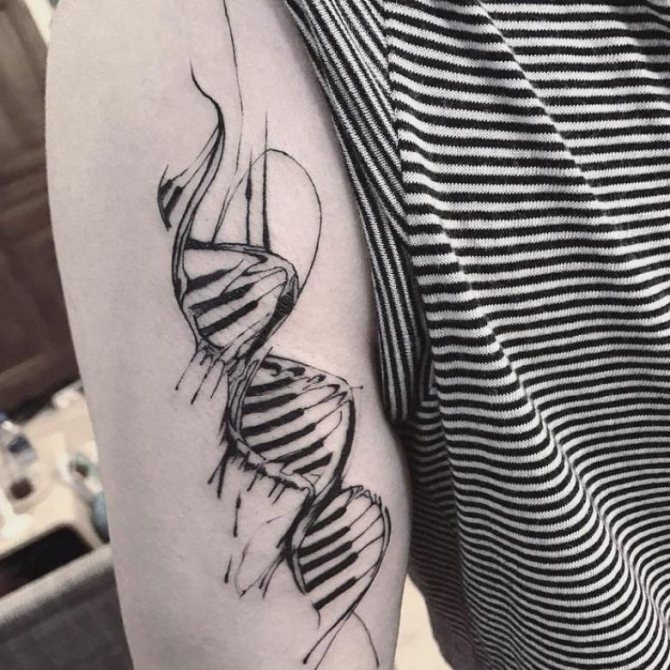

Tattoo chains DNA has long ago won its place in the tattoo culture. Certain segments of the population continue to decorate their bodies with the pattern of the molecule. In appearance and essence, the image of the macromolecule is positive. To the owner of the tattoo it can carry only positive emotions. It probably has no esoteric function.
Influence on the destiny
So how do tattoos affect fate? As a result of studies, it was found out that body art can be constructive and destructive. The same image can have opposite meanings in different people. The answer lies in the subconscious of the person himself, in the goals and reasons for which he chose a particular image.
A person gives mystical properties to a tattoo, sometimes without even being aware of it. Any body image is made for a reason. The owner puts into it a special meaning, for a long time nurtures the idea of the sketch and as a result realizes the conceived idea. All this long process is accompanied by certain emotions and experiences, which influence the subconscious of the person. He is so focused on the tattoo that he himself "charges" it, and it affects the further life and destiny.
Take, for example, the image of an eagle or a tiger. If the bearer of such a tattoo has a strong willed character, the tattoo will only emphasize his merits, strengthen faith in their own strength and will serve as a stimulus to further self-improvement. A soft, modest, indecisive person with such a drawing will only aggravate the inner conflict. Trying to conform to an unattainable image, he is even more disappointed in himself. All of this has a negative impact on the psyche. This is one vivid example of how the same tattoo can have destructive or creative properties.
Choose a tattoo that fits your image and emphasizes your personality. Do not try to appear to be something that you are not. This will disturb your inner harmony, and such an experiment will have a negative effect on the psyche, the body, and later on the destiny. Correctly chosen tattoo will help a person to fight against disadvantages and development of virtues.
Avoid unfamiliar symbols (for example, hieroglyphs or inscriptions in a language unknown to you). You can misinterpret the image and thereby distort your destiny. Be especially careful with images of witches, bones, skulls, a goat's head and foreign-language symbols, as you can activate destructive energy and demons.
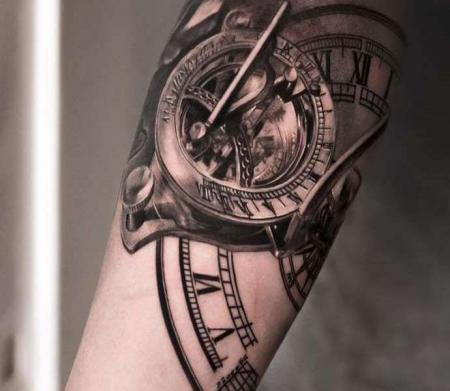

There is another aspect to the tattoo. It has two meanings both good and bad. Very often, if the tattoo is done by a good master who understands the meaning of the image he puts on the skin, the tattoo "glows" on the subtle plane as a beacon.
This beacon makes it very easy to trace a person's location and what they are doing at the moment. It is possible to influence such a tattoo and what reflects the tattoo on the subtle plane, that is, on the tattoo bearer himself, through some energy plane. This of the unpleasant aspects, for the bearer of the tattoo.
From the positive aspects is that the tattoo can be a personal totem-protector or determine the wearer's affiliation to any clan (aggregor), i.e. to warn that this tattoo bearer is under the protection of some clan forces.
But, by and large, identifying oneself with the help of a tattoo on the body, both socially and energetically, is not a very good thing. In any case, you position yourself, i.e. attract attention to yourself. You are manifesting yourself as an object, which is available for influence. And for influence of any nature, including magical.
I don't think that most mage practitioners actively seek "overt prominence" on the energetic levels of reality. In some cases, a magical formula or magical totem placed on the skin in the form of a tattoo blocks further development of the mage practitioner. A pierced skin, anywhere in the physical body, disrupts the movement of energy through the subtle energy channels that permeate our whole body. And certainly if a tattoo is applied to the area of any chakra channel outlet, the effect of such impact is rarely positive and beneficial to the tattoo bearer.
In principle, any magical sign put on the body with a tattoo changes the normal flow of energy in the energetic system of a person and most often in the direction of "voluntary blocking of energy flow". A tattoo on the physical body is always a "sacrifice" (as punctured skin is always bleeding. Blood magic is a serious thing) in the name of something, someone for a purpose. Voluntarily sacrificing oneself, one's energy structure to something is a denial of one's "freedom of choice. And, this is what the Creator "rewarded man" with.
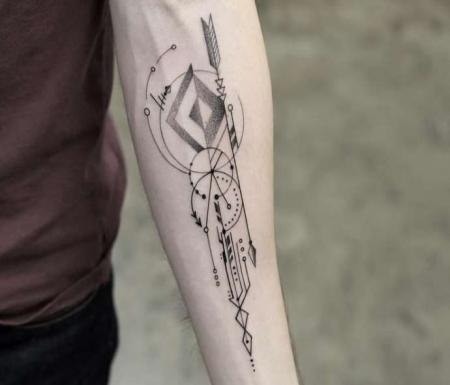

So, a little bit about blood magic. I want to warn and "scare a little". But first, a small digression.
How an icon is prepared for painting, what the iconographer does before starting the work. The oak boards (blanks) are dried in a dark and dry room, where there is natural air circulation. Then the boards are glued with a natural glue, which is brewed specially. This was certainly the case before, today the glue is bought in stores, but one way or another, the glue must consist of natural ingredients.
Next, the levkas is prepared, this mixture uses a chicken egg, namely the yolk. The resulting mixture is a bioenergy mass (mixture), which is applied to the prepared base - oak boards. All together - this forms the basis for a magical "living" artifact, on which will be imposed "magical drawing" - the face of a saint. But, before this, the iconographer himself must undergo the necessary treatment (preparation). First of all, fasting (three days to a week), secondly purification, and thirdly the consecration of the intention (the goal of his subsequent work). This is approximately like this without going into a lot of specific details. This is how the magical artifact - the Icon - was prepared.
Now let's return to our tattoo salon, to the place where we wanted to make ourselves any tattoo. Let's skip some of the details of the process and think about a few important things.
So, the artist himself. How experienced is he? Does he evoke a sense of "body and soul" purity? Is he friendly to you? Is he calm of mind and emotion at the sight of you? Maybe the "master" at all with a hangover, or after another quarrel with his girlfriend or wife. And is he thinking about you at the moment of his work? And if he does, how?
Well, let's say that we are satisfied with everything and the interior of the salon and the master himself, satisfy us according to some of our criteria. What else we need to remember and be sure to know. The meaning of your drawing, your tattoo is important - it's very important. And, of course, the most important thing is the magic of blood, some aspects of its action. One way or another, it will be present in the further process of tattooing on the body (on the skin).
When a tattoo is applied, the skin is punctured, with small capillaries punctured by a needle, and drops of blood flow out. These "holes" line the tattoo pattern. The blood is impregnated with the tattoo design itself, i.e. there is a blessing and activation of tattoo (tattoo design already becomes magic and has an energetic influence on your energetic structure).
Let's assume that you have chosen, consciously and intelligently, the tattoo pattern you need (i.e. you have prepared yourself). But what is the artist himself thinking when he puts the tattoo on your skin? What are his thoughts at that moment? Where is the guarantee that the master at this moment is thinking positively, and not thinking about some problem in his life. One way or another, the master tattooist puts an energetic imprint of his thoughts on his work (on your tattoo).
So, three processes are interconnected - blood, drawing (tattoo), energetic message (thoughts) of master tattooist, in the process of tattooing (additional and of great importance is the meaning of the drawing itself, your tattoo). How positive are the energies (emotions, thoughts) of the master? What does he impose on your artifact (skin+blood+drawing) at the moment, voluntarily or involuntarily, consciously or subconsciously.
What energy matrix is superimposed on your artifact? (The tattooist's thoughts are like a stipulation to a runic stanza. Only a thought-form is much stronger than a verbal spell - words spoken aloud. Since blood, very strongly consumes energy and itself is an active bioenergetic substance, at the moment of its manifestation on your skin).
I do not think that most master tattooists before their work undergo a similar cleansing ritual as the master icon painter. Hardly, though in "good salons", where they work with you individually, it is quite possible that tattoo masters undergo such training. But, it is expensive, like any individual work with a client. Here, roughly, such thoughts should go through your head if you have decided to get yourself a tattoo.


